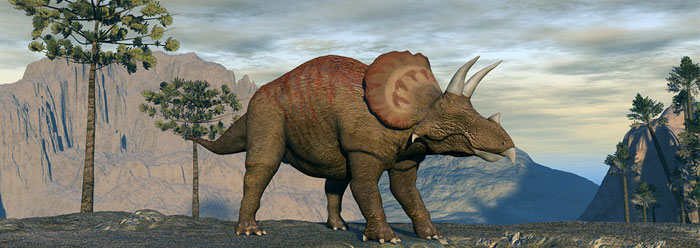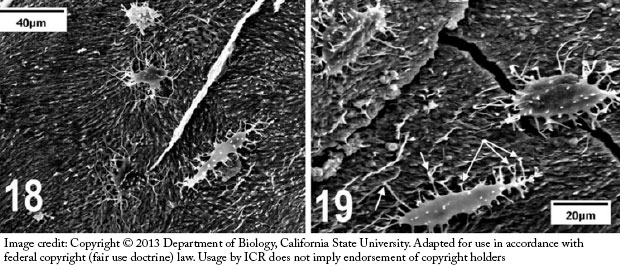
 Triceratops Horn Soft Tissue Foils 'Biofilm' Explanation
Triceratops Horn Soft Tissue Foils 'Biofilm' Explanation
by Brian Thomas, M.S. *
http://www.icr.org/article/7382/Decades ago, when researchers began publishing their discoveries of transparent, floppy tissue with recognizable intact cells inside dinosaur bones, plenty of shocked evolutionists disputed their results. After all, nobody knew—and still nobody knows—a process whereby flesh and bones could persist over the eons that evolutionists insist dinosaur fossils have endured.
One popular pushback asserts that the soft tissues are not from the dinosaurs at all, but from bacteria that somehow infiltrated their bones and built biofilms in the same shapes as dinosaur tissues and cells. A new report of eight-inch long sheets of soft tissue inside a 22-inch long triceratops horn presents three difficult hurdles for the "bacterial biofilm" hypothesis, which suggests that certain species of bacteria manufactured a polysaccharide film that took the shape of each dinosaur tissue that they consumed millions of years ago, before the dino flesh decayed.
Two biology professors coauthored the report in Acta Histochemica.1 Their electron micrographs (below) show fine detail inside the bony triceratops "horn core." The authors obtained the horn from the Hell Creek Formation in Montana, famous for its well-preserved dinosaur remains. The horn was damp when removed from rock, and it soon broke into several pieces, showing that it was already fractured. The researchers therefore suspected that bacteria could have penetrated the horn through these cracks and lived on the nearby liquid. Despite what promised to be a bacteria-friendly environment, the soft tissue they found looked nothing like bacterial biofilms.

The research pair demineralized part of the bone by soaking pieces of it in a mild acid bath for a month. Soft tissues emerged as some of the dinosaur bone's original minerals departed. The study authors found "large strips of thin, light brown, soft material (20 cm by 10 cm)." They also identified bone cells called osteocytes, "including internal nucleus-like spheres, primary and secondary filipodia, and cell to cell junctions."1
The first hurdle for the bacterial biofilm story to face is that no known biofilm looks just like bone cells, complete with their thin "filipodia" extensions. Second, wouldn't the supposed bacteria deposit their biofilms on the bone's outer surface even more readily than deep inside the bone? Yet the study authors found no biofilm there. And they described yet a third hurdle when they wrote, "What is also not clear is how such biofilm structures could themselves survive the ravages of time."1
This report of triceratops soft tissue adds to the long list of discoveries of original skin, blood vessel, blood and bone components found in tyrannosaurs, hadrosaurs, titanosaurs, psittacosaurs, Sinosauropteryx, and other animals.2 Bacterial biofilms neither match nor explain any of these finds. Is it time to interpret dinosaur fossils as recent sedimentary deposits from a global flood recorded in Genesis?3 The fossils say yes!
References
- Armitage, M.H., and K. L. Anderson. Soft sheets of fibrillar bone from a fossil of the supraorbital horn of the dinosaur Triceratops horridus. Acta Histochemica. Published online before print, February 13, 2013.
- Thomas, B. Published Reports of Original Soft Tissue Fossils. Posted on icr.org July 21, 2011, accessed March 6, 2013.
- Morris, J. and F. Sherwin. 2010. The Fossil Record. Dallas, TX: Institute for Creation Research.
* Mr. Thomas is Science Writer at the Institute for Creation Research.
Article posted on March 18, 2013.


No comments:
Post a Comment